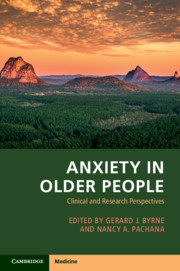Book contents
- Anxiety in Older People
- Anxiety in Older People
- Copyright page
- Contents
- Contributors
- Chapter 1 Introduction and Conceptual Overview
- Chapter 2 Epidemiology, Risk and Protective Factors
- Chapter 3 Diagnosis of Anxiety Disorders in Older Adults
- Chapter 4 Subthreshold Anxiety in Later Life
- Chapter 5 Cross-cultural Issues in Late-Life Anxiety
- Chapter 6 Clinical Assessment of Late-Life Anxiety
- Chapter 7 Late-Life Anxiety and Comorbid Depression
- Chapter 8 Anxiety and Cognitive Functioning
- Chapter 9 Anxiety in Parkinson’s Disease
- Chapter 10 Anxiety in Older Adults across Care Settings
- Chapter 11 Psychosocial Treatment of Anxiety in Later Life
- Chapter 12 Pharmacological Treatment of Anxiety in Later Life
- Chapter 13 Animal Models in Anxiety Research
- Chapter 14 Late-Life Anxiety
- Index
- References
Chapter 1 - Introduction and Conceptual Overview
Published online by Cambridge University Press: 08 March 2021
- Anxiety in Older People
- Anxiety in Older People
- Copyright page
- Contents
- Contributors
- Chapter 1 Introduction and Conceptual Overview
- Chapter 2 Epidemiology, Risk and Protective Factors
- Chapter 3 Diagnosis of Anxiety Disorders in Older Adults
- Chapter 4 Subthreshold Anxiety in Later Life
- Chapter 5 Cross-cultural Issues in Late-Life Anxiety
- Chapter 6 Clinical Assessment of Late-Life Anxiety
- Chapter 7 Late-Life Anxiety and Comorbid Depression
- Chapter 8 Anxiety and Cognitive Functioning
- Chapter 9 Anxiety in Parkinson’s Disease
- Chapter 10 Anxiety in Older Adults across Care Settings
- Chapter 11 Psychosocial Treatment of Anxiety in Later Life
- Chapter 12 Pharmacological Treatment of Anxiety in Later Life
- Chapter 13 Animal Models in Anxiety Research
- Chapter 14 Late-Life Anxiety
- Index
- References
Summary
Historically, clinicians and researchers interested in the mental health of older people have focused on depression and dementia and have given little attention to anxiety except as a complication of depression or dementia. Over recent years, however, research into anxiety in older people has increased substantially, leading to both a burgeoning scientific literature and increasing clinical interest in the field.
- Type
- Chapter
- Information
- Anxiety in Older PeopleClinical and Research Perspectives, pp. 1 - 9Publisher: Cambridge University PressPrint publication year: 2021

